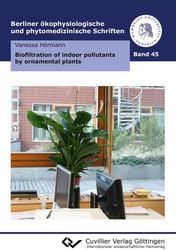| Areas | |
|---|---|
| Serie de libros (96) |
1378
|
| Nachhaltigkeit |
3
|
| Gesundheitswesen |
1
|
| Letra |
2364
|
| Ciencias Naturales |
5406
|
| Matemática | 229 |
| Informática | 319 |
| Física | 980 |
| Química | 1363 |
| Geociencias | 131 |
| Medicina humana | 243 |
| Estomatología | 10 |
| Veterinaria | 108 |
| Farmacia | 147 |
| Biología | 835 |
| Bioquímica, biología molecular, tecnología genética | 121 |
| Biofísica | 25 |
| Nutrición | 45 |
| Agricultura | 1004 |
| Silvicultura | 201 |
| Horticultura | 20 |
| Ecología y conservación de la tierra | 148 |
| Ciencias Ingeniería |
1793
|
| General |
98
|
|
Leitlinien Unfallchirurgie
5. Auflage bestellen |
|
Erweiterte Suche
Biofiltration of indoor pollutants by ornamental plants (Volumen 45) (Tienda española)
Vanessa Hörmann (Autor)Previo
Lectura de prueba, PDF (270 KB)
Indice, PDF (37 KB)
The impact of plants on indoor air quality and the examination of a putative interrelation between plant physiology and pollutant removal were investigated in the presented thesis. Moreover, the impact of plants on human well-being in the working environment was examined. Experiments in test chambers revealed that the uptake of pollutants (toluene and 2 ethylhexanol) by plants is very limited, i.e. a removal rate of 2 – 5 L h-1 m-2 leaf area, corresponding to about 20 – 100 µg h-1 m-2 leaf area. Furthermore, the impact of plant physiological parameters was found to be negligible for the uptake of the two tested pollutants. It was shown that the pollutant uptake depends mainly on sorption to plant surfaces. A field study verified that one big plant (Spathiphyllum wallisii) in a 20-m² office has no detectable impact on indoor air quality in regard to concentration of volatile organic compounds, temperature and relative humidity. The well-being of office workers could not be improved by the plant and it is suggested that effects of plants on humans in the working environment are rather small and subject to a more complex system of varying factors.
| ISBN-13 (Impresion) | 9783736998155 |
| ISBN-13 (E-Book) | 9783736988156 |
| Formato | A5 |
| Idioma | Inglés |
| Numero de paginas | 124 |
| Laminacion de la cubierta | mate |
| Edicion | 1. dünne Folie, NM auf neuem Rechner |
| Serie | Berliner ökophysiologische und phytomedizinische Schriften |
| Volumen | 45 |
| Lugar de publicacion | Göttingen |
| Lugar de la disertacion | Berlin |
| Fecha de publicacion | 19.06.2018 |
| Clasificacion simple | Tesis doctoral |
| Area |
Agricultura
|
| Palabras claves | Biofiltration, Indoor air, Indoor air quality, Pollutant removal, Ornamental plants, Indoor plants, Indoor pollutants, Volatile organic compounds, VOC, Toluene, 2-ethylhexanol, Pollutant removal rate, Indoor air purification, Pollutant uptake, Plant physiology, Photosynthesis, Quantum yield, CO2, Gas exchange, Transpiration, Respiration, Phytotoxicity, Dieffenbachia maculate, Spathiphyllum wallisii, Asparagus densiflorus, Biobox, Test chamber, Chamber experiments, Human health, Well-being, Stress, Working environment, Office workers, Placebo effect |








